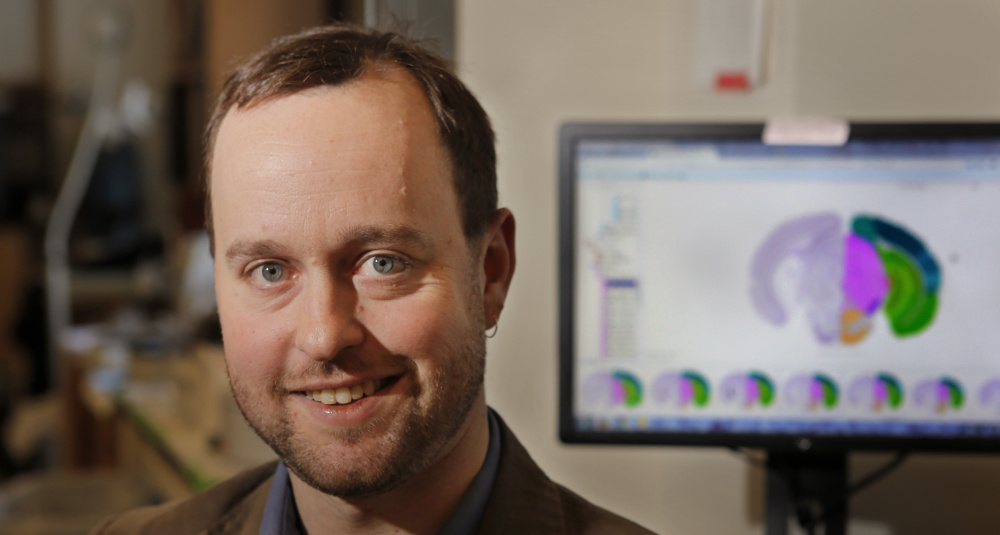In many ways the brain remains a mystery to scientists, who say that even basic functions such as how the brain gains consciousness and becomes self-aware are not understood.
So with someone like Taylor Norcross, who suffered a severe head injury in a moose-car collision on Nov. 4, the best doctors can do is give the brain optimal conditions to heal on its own.
“There’s still so much that we don’t know,” said Michael Burman, a professor of neuroscience at the University of New England.
“We don’t have a way to go in and fix what’s wrong. You can’t repair those connections that have been sheared. I wish we could,” said Dr. David Burke, an emergency room doctor who treated Norcross. “What we can do is preserve what’s left. What we’re doing is helping the brain to help itself.”
LETTING BRAIN HEAL
Norcross, 27, of Auburn was asleep in the front passenger seat when the car being driven by her fiance, Frank Gatto, slammed into a moose near the Gray exit of the Maine Turnpike on the night of Nov. 4. The force of the collision ripped the top off Gatto’s Infiniti sedan, and the moose hit Norcross in the head, probably in the front.
Gatto, who emerged from the crash unscathed, did not see the moose hit Norcross, but moose hair was still found in Norcross’ head weeks later.
The impact knocked her out, and she was rushed to Central Maine Medical Center in Lewiston.
Doctors used drugs to put her into a coma and relieve the pressure in her brain, and closely monitored her vital signs as they took other steps to stabilize Norcross and, hopefully, let her brain heal.
“If you break your wrist, we can tell you what’s going to happen and how long it’s going to take to recover. But predicting what damage to the brain has been done and what the recovery is going to look like is very imprecise. We don’t understand the brain that well to be able to do that,” Burman said.
A dangerous threat to the brain is the inflammation that occurs after suffering a traumatic head injury. That’s why relieving brain pressure through techniques such as reducing fluid buildup in the skull is key.
“If you hurt your knee, your knee might swell up, and that’s how the knee heals,” Burman said. “But the skull is closed, so when the brain swells, there’s nowhere for the brain to go, and that pressure can cause more brain cells to die.”
Once the brain is stabilized, it’s a wait-and-see approach to recovery.
One of the first signs of recovery is being able to track something with your eyes across a room, Burke said.
Scientists do know that the recovering brain attempts to compensate for damaged brain cells and lost connections caused by severed neurons.
The brain has about 100 billion neurons that transmit electrochemical signals to one another, which is how we think and control our body’s functions. The brain, especially in the cortex – which controls thinking and motor skills – has neuroplasticity, or built-in redundancies and the ability to compensate for lost brain cells, Burman said.
When someone loses vision, for example, the brain responds by heightening other senses, such as touch and hearing.
NEW PATHWAYS
Norcross’ injuries occurred throughout her brain, but the most severe were in the frontal lobe cortex on the left side, which controls the right side’s motor skills.
When the brain recovers from an injury, the neurons “find new pathways,” Burke said, learning new ways to do the same tasks. But in some cases, the brain is too damaged to recover sufficiently and patients need to live in a nursing home for the rest of their lives.
“She could have been in a vegetative state,” Burke said.
In Norcross’ case, it was a waiting game.
Within weeks, she awoke from her coma, and to the amazement of hospital staff, almost immediately began walking, talking and writing. Her right arm and leg took a few days longer to recover, but her motor skills are now near 100 percent.
She is attending an outpatient clinic at River Ridge in York County, working on her short-term and long-term memory, cognitive skills, focus and ability to pay attention to multiple things at the same time. Her mental ability is about 85 percent of where she was before the accident, Burke said, with an excellent prognosis to almost fully recover.
But because the brain is learning new ways to do tasks, some things will never be the same as they were before the traumatic injury, Burman said. The differences can be subtle. For instance, someone may tie their shoes differently, answer the phone in a new way, talk or write differently or be unable to recall a common word.
Or their personalities can be markedly different.
“Your brain controls your emotional and social skills, your personality,” Burman said. “In some ways, you’re coming back as a different person.”
Thomas McOsker, a therapist from New England Rehabilitation Hospital of Portland, where Norcross was an inpatient for about two weeks in December, said that even for someone doing as well as Norcross in recovering from a brain injury, it’s still a long process.
McOsker said the emotional recovery should not be discounted. As a coping mechanism, the brain will block out a deep understanding of the circumstances and experience of an injury so that it can focus on healing. But once the brain has recovered to a certain point, it allows you to start realizing what happened.
“As far as truly understanding the impact of what happened, that hasn’t hit her yet,” McOsker said. “But she has a great chance for a positive cognitive, emotional and social recovery.”
Send questions/comments to the editors.




Comments are no longer available on this story